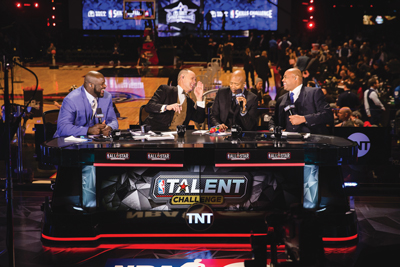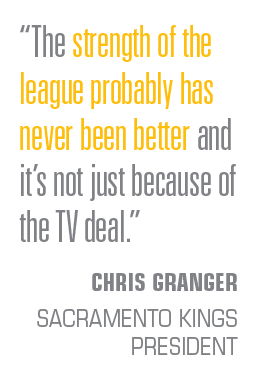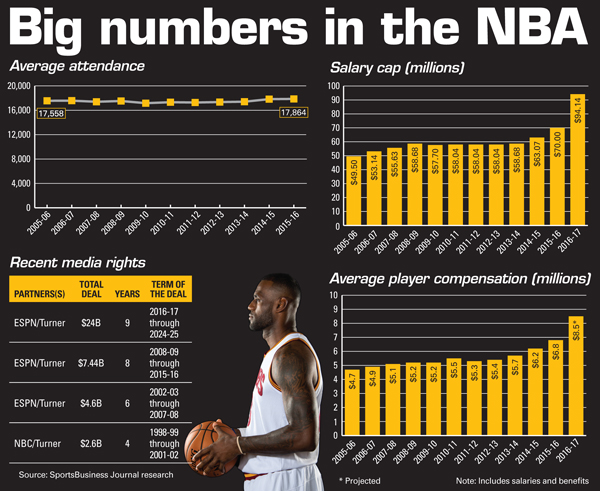The NBA tips off its 2016-17 season with a cascade of cash.
The league expects to reach $8 billion in revenue this season, according to sources familiar with league finances. That’s a 23 percent jump from the $6.5 billion in league revenue for the 2015-16 season, and up 54 percent from the $5.2 billion in 2014-15.
While media rights fees have fueled much of the rise, the league has enjoyed growth at the gate, in sponsorship sales, and nearly every other key business metric.
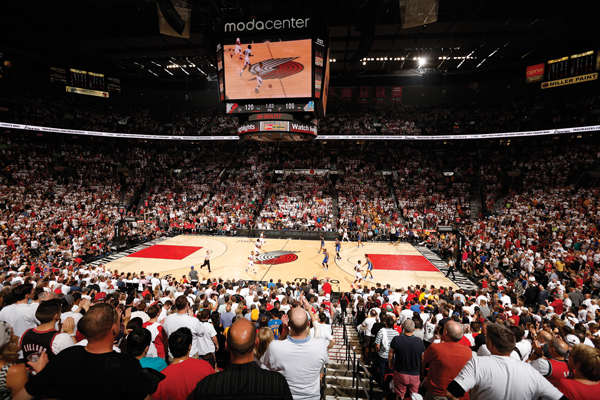 |
Sources put the league’s gate at roughly $1.5 billion while a new TV deal with ESPN and Turner is worth $2.6 billion annually.
Photo by: NBAE / Getty Images (2) |
“The strength of the league probably has never been better and it’s not just because of the TV deal,” said Sacramento Kings President Chris Granger. “Season-ticket sales continue on a record pace and teams are unlocking digital in new ways. Teams are also getting smarter in how to monetize ancillary businesses and the engine is humming. And by the way, the product is great.”
It’s a thriving NBA business climate compared not only to the last few seasons but also to the 2011-12 lockout-shortened campaign that brought a new collective-bargaining agreement.
That deal gave the league and National Basketball Players Association until Dec. 15 of this year to opt out of the agreement. At press time, the two sides were nearing a new labor agreement, and had expressed optimism for getting it done.
Underpinning the CBA talks is the league’s explosive business growth. In 2011 during the lockout-shortened season, the league had $4.4 billion in revenue, which consisted mainly of media rights, sponsorship, gate and international money. That’s about half of the expected revenue generated this season.
The league’s jump in revenue is due mostly to the start of a nine-year, $24 billion media-rights deal with ESPN/ABC and Turner. The deal tripled the value of the old agreement. ESPN will pay the league an average of $1.4 billion annually and Turner an average of $1.2 billion per year. That combined $2.6 billion annual media-rights payment is nearly 180 percent higher than the total of $930 million the networks paid annually under the previous agreement. The networks are banking on the league’s current momentum to continue after last year’s NBA Finals on ABC were the most viewed Finals since 1998.
The revenue gains come during a period that also saw skyrocketing franchise values
(see story) and the addition of new leaguewide sponsors. Sources put the league’s gate at roughly $1.5 billion with combined total team sponsorships at about $600 million, with about $500 million in league deals. Local media deals account for about another $650 million annually.
While the league’s domestic business has yet to run out of runway, its international push continues to pay off as well. For example, the NBA is entering the second year of a five-year, $700 million deal with Tencent for live-streaming rights in China.
Even some of the team’s struggling markets are on the financial upswing, such as the Sacramento Kings, whose new $557 million arena is driving the team’s business.
It’s not only the teams reaping the financial benefits. Players are also profiting greatly given that the salary cap this year hit a record $94 million, up 34 percent from $70 million last season, due to the enormous revenue increase.
)
The rise in the cap created a frenzy in team spending this past offseason, with teams doling out more than $3 billion in free agency player salaries, more than double the spending from two years ago, as both superstars and marginal players alike cash in on the flood of new money. Consider that a player like Timofey Mozgov, who last year was a backup for the Cavs, this offseason signed a four-year, $64 million contract with the Los Angeles Lakers, highlighting the NBA’s free-spending ways.
The average player compensation this year is around $8.5 million, including salary and benefits. That’s up from $6.8 million last season.
Add it all up, and it’s been a wild financial surge under the first two years of Commissioner Adam Silver’s tenure.
And while NBA revenue ranks far behind the NFL’s $13 billion to $14 billion in annual revenue expected this season, the league is drawing closer to MLB’s $10 billion in annual revenue. The NHL generates $4 billion in annual revenue.
What’s next for league?
Despite the run-up in NBA revenue, longtime league insiders see far more room to grow compared to other major U.S. sports given basketball’s global reach.
“Football is played in the U.S., baseball is played primarily in the U.S., but basketball is played in China and it is popular in India,” said longtime agent David Falk. “It is played and broadcast in over 200 countries. The TV contracts are through the roof, and the system is working damn well in the macro view.”
But at least one league owner is putting a damper on the league’s new economic order even with the huge infusion of media money.
While the league refuses to disclose specific team profitability information, Los Angeles Clippers owner Steve Ballmer, who stunned the NBA by paying $2 billion to buy the Clippers in 2014, said his team is operating at a loss.
The following are results of the Turnkey Sports Poll taken in September. The survey covered more than 2,000 senior-level sports industry executives spanning professional and college sports.
By moving the 2017 All-Star Game from Charlotte, the NBA …
| Made the right decision |
60% |
| Made the wrong decision |
24% |
| Not sure / No response |
16% |
Is the creation of the Warriors “super team” this offseason good or bad for the overall popularity of the NBA?
| Good |
47% |
| No effect |
17% |
| Bad |
29% |
| Not sure / No response |
7% |
How many NBA teams will secure jersey patch partners before the start of the 2017-18 season?
Which of the following NBA sponsorship assets deliver more benefits to a sponsor than a jersey patch, if any? (Note: Respondents could select all that apply.)
| Arena naming rights |
59% |
| Floor/apron naming rights |
37% |
| Category exclusivity |
21% |
| Entitlement zone in the venue |
10% |
| None of these |
16% |
| Not sure / No response |
6% |
Compared to a year ago, how excited are you about the upcoming NBA season?
| More excited |
11% |
| As excited |
48% |
| Less excited |
30% |
| Not sure / No response |
11% |
Source: Turnkey Sports & Entertainment in conjunction with SportsBusiness Journal. Turnkey Intelligence specializes in research, measurement and lead generation for brands and properties. Visit www.turnkeyse.com.
The Clippers have one of the NBA’s highest payrolls at $114 million and as a result pays millions of dollars in the league’s luxury tax assessed to teams that exceed the salary cap.
“I’m a new owner, and I’ve heard this is the ‘golden age of basketball economics,’” Ballmer said at the recent NeuLion Sports Media & Technology conference. “You should tell our finance people that. We’re sitting there looking at red ink, and it’s real red ink. I know; it shows up on my tax returns. OK, some of that is decisions we make, going with a luxury tax, etc., but there’s still real issues.”
While Ballmer sees red on the Clippers’ balance sheet, he can also look at a rise of NBA franchise values as a sign of the league’s fiscal health.
This summer, the Golden State Warriors were valued at $1.6 billion as part of a limited partnership sale, a value almost rivaling Ballmer’s $2 billion price for the Clippers that was seen as overly inflated when he bought the franchise in 2014.
The Warriors valuation is also more than double the $450 million that Joe Lacob and Peter Guber paid to buy the team in 2010.
Last year, the Atlanta Hawks sold at a valuation of $840 million while the Brooklyn Nets in December were valued at $875 million as part of controlling owner Mikhail Prokhorov’s purchase of a large minority share.
Franchise values, according to Bob Caporale, chairman of Game Plan, which brokered the minority stake sale of the Warriors this summer, are expected to at least hold given the current economic health of the league.
“I don’t think there is a bursting of the bubble,” he said. “There is some flattening but it has been leaping forward with the new media deal and the content it provides.”
There could also be a flattening of season-ticket sales as some teams hold back on inventory. Last year, the NBA sold a record of nearly 300,000 full-season tickets as the league set an attendance record of 17,864 fans per game and had a record 723 sellouts. The league last season also filled its arenas to a record 94 percent capacity.
While teams like the Charlotte Hornets, Milwaukee Bucks and Philadelphia 76ers have plenty of season-ticket runway, other teams like the Golden State Warriors and Cleveland Cavaliers are limiting full-season sales in order to attract a wider fan base through partial plans and individual game sales.
“Teams are beginning to pay attention to inventory management,” said Amy Brooks, executive vice president of team marketing and business operations for the NBA. “We are going to be close to last season. It is a balance. It’s not always selling as many season tickets as you can. It is about getting as many different fans in as well.”
Brooks said the teams with the highest number of new full-season tickets sold to date this year in no specific order are the Kings, 76ers, Hornets, Boston Celtics and Orlando Magic.
“Season-ticket sales could slow, but the number of tickets sold will continue to grow,” said Bill Sutton, who runs a sports consultancy that counts NBA teams such as the Sixers, Minnesota Timberwolves, and Phoenix Suns as clients. “You can’t just limit sales to season tickets. You have to create an audience and provide access to go to a game.”
But Sutton warned that the league could get hurt by a proliferation of “super teams” following Kevin Durant’s offseason signing with the Warriors.
“Multiple super teams would be great for television viewership, but it sends the message that not all NBA teams can compete,” he said. “That is the flag I see.”
Continued sponsorship growth both at the team and league levels also are adding to the NBA’s top-line revenue.
“Team sponsorship is as strong as it’s ever been with bigger and more integrated deals,” Brooks said, declining to comment on any sponsorship revenue specifics.
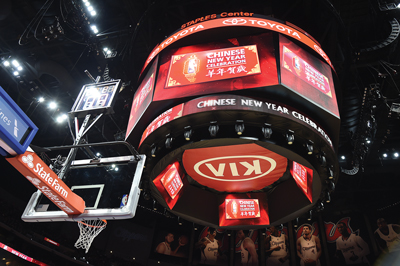 |
Sources say team sponsorships total about $600 million while league deals total about $500 million.
Photo by: NBAE / Getty Images |
The NBA this season has added a multiyear leaguewide deal with ExxonMobil that includes the Chinese market and fills the long-vacant motor oil category.
The league last year also added Tissot as a sponsor in a new timing category while Pepsi begins its second season this year as the league’s official food and beverage sponsor.
Other deals on tap for next season will add to the NBA’s financial growth. Nike is set to replace Adidas as the league’s uniform supplier next season with an eight-year deal estimated to be worth $1 billion.
Also on the horizon is jersey advertising revenue. The league this spring allowed teams to start selling advertising that will appear on jerseys beginning with the 2017-18 season. Only two teams to date, in the Kings and the Sixers, have jersey patch advertising deals, worth $15 million each over three years, but more deals are expected. While it’s impossible to predict exactly how much money the jersey patch deals will generate, early estimates put total jersey patch revenue at about $150 million, with teams keeping half of the money and the other half going into the league’s revenue-sharing pool.
“If it’s a growing healthy sport, sponsors want to be involved, and the fact is that the NBA seems to be in front of the issues,” said David Grant, principal of marketing agency Team Epic and a former NBA sponsorship sales executive. “They see around corners and they are ahead of the curve.”



